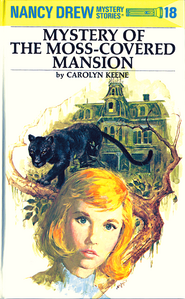
1971 cover art.
The Mystery at the Moss-Covered Mansion (retitled Mystery of the Moss-Covered Mansion in 1971) is the eighteenth volume in the Nancy Drew Mystery Stories series. In it, Nancy and her friends go to Florida and experience odd happenings around a moss-covered mansion. This is one of eight titles that had a plot change in the revision process by the Stratemeyer Syndicate.
Plot summary[]
1941[]
Nancy's father Carson Drew enlists her help in tracking down a missing heiress, and Nancy, Bess, and George stumble upon a mysterious moss-covered mansion. They later hear that someone was murdered near the mansion and they hear strange noises coming from inside.
The volume is 25 chapters in length, and includes a great deal of action, including a murder, gypsies, a missing heiress, a needy elderly lady, a reclusive artist, an airplane accident, and a forest fire.
1971[]
Now retitled "Mystery of the Moss-Covered Mansion", a friend of Nancy's father has been arrested and charged with sending a truck loaded with explosive oranges into the Space Center complex at Cape Kennedy. Knowing that he could not possibly be guilty of sabotage, Nancy and her father rush to the defense of the accused innocent man.
During the Drews' investigation, Nancy becomes suspicious of an old, spooky mansion. Behind a high mesh enclosure, wild African animals roam about the extensive grounds. Nancy discovers that something besides the training of wild animals is going on at the mysterious moss-covered mansion estate.
Adult critics among collectors groups comment on strange elements of the revised story frequently, including explosive oranges, and a spy-thriller climax with Ned and Nancy trapped in the house, nearly dying before rescue.
Artwork[]
The original dust jacket was painted by Russell H. Tandy, and depicts Nancy, Bess, and George digging for buried money on the grounds of the title location. Tandy also illustrated the frontispiece, which was a pen-and-ink drawing on plain paper. In previous titles, the frontpiece - and in earlier volumes, the illustrations - had used glossy paper with highly detailed black-and-white art.
In 1962, Rudy Nappi updated Tandy's cover art to set the scene in the 1960s. Nappi also provided the 1971 cover art the accompanied the revision. An uncredited artist provided five internal line drawings and a frontispiece for the revised text.
Trivia[]
- This was the final book to be outlined by Edna Squier.
